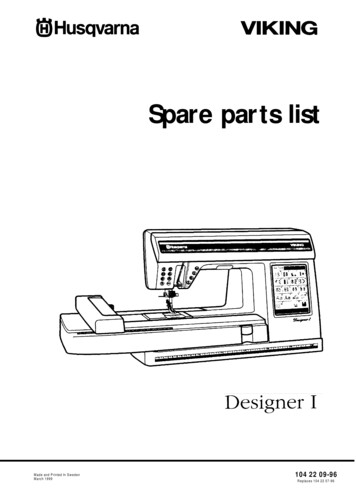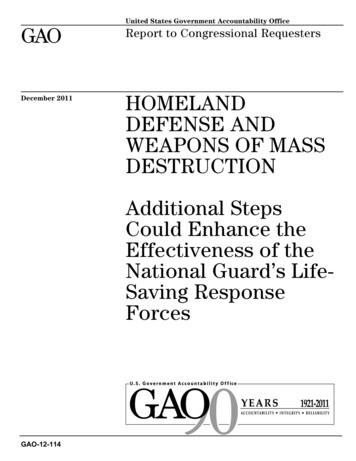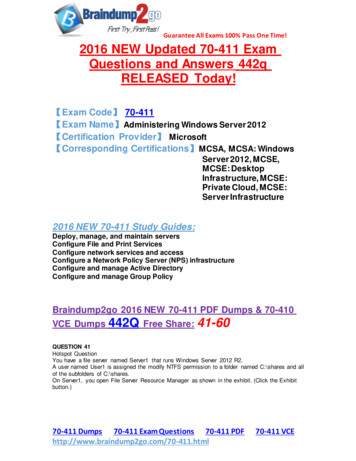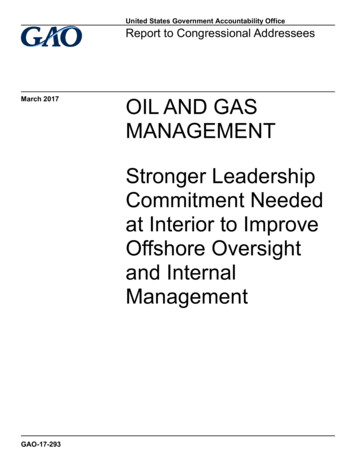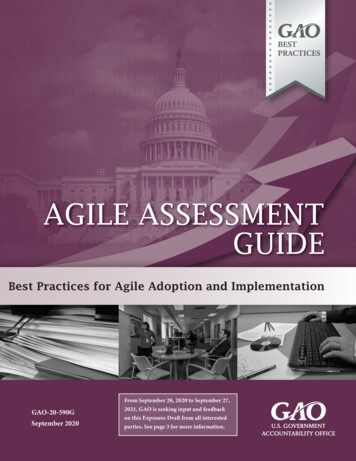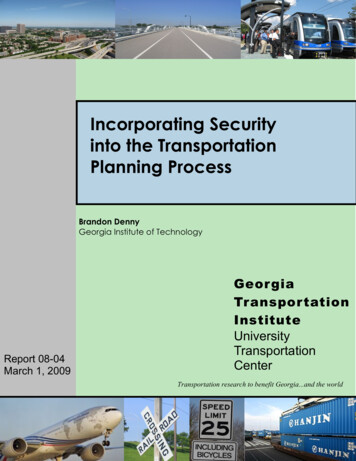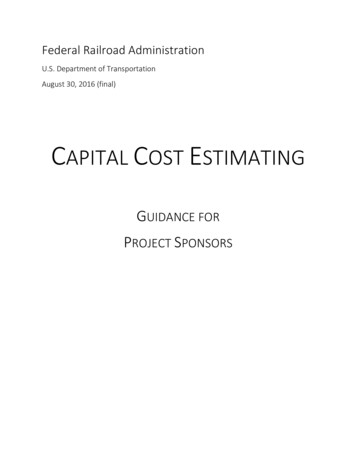
Transcription
United States Government Accountability OfficeReport to Congressional CommitteesAugust 2021DEFENSETRANSPORTATIONThe Army ShouldTake Action to BetterEnsure Adequate RailSupport to CombatantCommandersGAO-21-411
August 2021DEFENSE TRANSPORTATIONHighlights of GAO-21-411, a report tocongressional committeesThe Army Should Take Action to Better EnsureAdequate Rail Support to Combatant CommandersWhy GAO Did This StudyWhat GAO FoundAccording to Army officials anddoctrine, rail is the most costeffective and expeditious means ofmoving large quantities of materiel,such as tanks and ammunition, overlong distances. Army officials alsostated that during contingencies,approximately 67 percent of Armyunit equipment moves by rail from itsfort or base of origin to a shippingport.The Army has taken some actions to provide rail operating crews, but has notdetermined requirements for the number of trained rail operating crews needed.Based on a 2015 analysis, the Army reduced its rail force structure by 70 percentto a single 180-person 757th Expeditionary Rail Center (ERC). As the Army’sonly rail unit, it provides railroad personnel to assess, plan, coordinate, andconduct rail operations to support the warfighter overseas. Although not part ofits mission, the 757th ERC also provides rail operating crews to support the railmovement of Army units in the continental U.S. (CONUS) as a stopgap measure.Officials stated that, since fiscal year 2018, the 757th ERC operated under anexception allowing them to support CONUS operations, and that the demand forthese crews in CONUS occurred frequently and regularly. Army officials statedthat a possible gap could exist in the event of a large mobilization as the unitwould be dedicated to its overseas effort and may also be called to supportCONUS movements. A 2020 Army study considered whether rail assets, such asthe number of trains, could meet requirements, but officials stated that it did notdetermine the number of rail operating crews needed to support a largemobilization. Determining this requirement and the risk associated with anyshortfall of crews would better position DOD to mitigate those risks.House Report 116-120,accompanying a bill for the NationalDefense Authorization Act for FiscalYear 2020, included a provision forGAO to review military railcapabilities. GAO evaluated theextent to which the Army has takenaction to 1) meet potential needs forrail operating crews and 2) inspect,repair, and monitor installations’ railtrack.DOD Personnel Moving Equipment on Non-Restricted TrackGAO reviewed Army studies,documents, and analyses about railoperating crew needs and themanagement and oversight of theArmy’s rail track network, andinterviewed Army and otherappropriate DOD officials.What GAO RecommendsGAO is making threerecommendations to the Army todetermine the requirement for trainedrail operating crews, quantify the risk ofany shortfall of crews, and require andimplement a quality assuranceprogram to inform decision-making inproviding oversight of rail trackconditions. The department concurredwith GAO’s recommendations.View GAO-21-411. For more information,contact Cary B. Russell at (202) 512-5431 orrussellc@gao.gov.The Army has undertaken efforts to manage the condition of its rail track, butchallenges remain in conducting inspections, using waivers, and funding repairs.For example, Army inspectors characterized about half of the Army’s rail track asclosed due to defects, and four of 60 installations had not met or were notscheduled to meet the 5-year ultrasonic inspection timeline standard set by theArmy inspection program. Although the Army has some quality assurance efforts,it has not established an overall quality assurance program to ensure that itstrack is inspected and that deficiencies are corrected according to existingprotocols. Without a quality assurance program, the Army will not have acomprehensive approach for its rail track and will not have coordinated oversightin managing efforts such as inspections and funding repairs.United States Government Accountability Office
ContentsLetter1BackgroundArmy Has Taken Steps to Evaluate and Improve Some RailCapabilities, but Has Not Determined Requirements for RailOperating CrewsThe Army Has Taken Actions to Inspect and Repair Rail Track,but Lacks a Quality Assurance Program to Ensure TimelyRepairsConclusionsRecommendations for Executive ActionAgency Comments and Our Evaluation10141516Appendix IComments from the Department of Defense17Appendix IIGAO Contact and Staff Acknowledgments20Page i35GAO-21-411 Defense Transportation
AbbreviationsAMCCONUSDODERCERDCEXORDFRASDDCUFCU.S. Army Materiel Commandcontinental United StatesDepartment of DefenseExpeditionary Rail CenterU.S. Army Corps of Engineers, Geotechnical andStructures Laboratory, Engineer Research andDevelopment Centerexecute orderU.S. Federal Railroad AdministrationMilitary Surface Deployment and Distribution CommandUnified Facilities CriteriaThis is a work of the U.S. government and is not subject to copyright protection in theUnited States. The published product may be reproduced and distributed in its entiretywithout further permission from GAO. However, because this work may containcopyrighted images or other material, permission from the copyright holder may benecessary if you wish to reproduce this material separately.Page iiGAO-21-411 Defense Transportation
Letter441 G St. N.W.Washington, DC 20548August 23, 2021The Honorable Jack ReedChairmanThe Honorable James M. InhofeRanking MemberCommittee on Armed ServicesUnited States SenateThe Honorable Adam SmithChairmanThe Honorable Mike RogersRanking MemberCommittee on Armed ServicesHouse of RepresentativesAccording to Army officials and doctrine, rail is the most cost effective andexpeditious means of moving large quantities of materiel, such as tanksand ammunition, over long distances. 1 Army officials also have stated thatduring contingencies approximately 67 percent of Army unit equipmentmoves by rail from its fort or base of origin to a shipping port. In 2003, forexample, nearly 1 million tons of unit equipment moved by rail in supportof Operation Iraqi Freedom. This is the rough equivalent of moving morethan twice the total number of M1-series tanks currently in the Armyinventory. 2The resources required to effect such a movement are sizeable as well. A2020 simulation of deployment from a single fort in support of a largescale combat operation demonstrated the need for more than 2,200 railcars over a 3-day period. 3 More than 600 of those cars were required tomove a single Armored Brigade Combat Team. This Army study alsonoted that such a movement would require a sufficient number of1ArmyField Manual 4-01, Army Transportation Operations (Apr. 3, 2014).2Accordingto the Army, the latest M1 Abrams tank variant, the M1A2 SEPv2, weighs 71.2U.S. tons. Commercial sources report that there are about 6,300 tanks in the U.S.inventory.3In the 2-year period 2017 through 2018, the Army reported an increased operationaltempo that included more than 135 opportunities to practice deployment or redeploymenttasks including brigade-size unit movements.Page 1GAO-21-411 Defense Transportation
qualified rail operating crews to operate the trains in addition to wellmaintained rail track over which the trains would travel. 4The House Armed Services Committee Report 116-120 accompanying abill for the National Defense Authorization Act for Fiscal Year 2020included a provision for us to examine the extent to which the Army hasassessed rail capabilities and addressed any identified gaps in meetingcombat requirements. 5 In this report, we examine the extent to which theArmy has taken actions to (1) meet potential needs for rail operatingcrews and (2) inspect, repair, and monitor installations’ rail track.To address the first objective, we reviewed documentation, such as Armystudies and analyses of rail operating crew needs and interviewed Armyofficials about the Army’s efforts to address gaps in rail capabilities. Wereviewed information contained in Army mobilization execute orders(EXORDs) to identify any potential shortfalls concerning the number ofrail operating crews that would be required to support a mobilization. Wealso compared the Army’s efforts to address potential shortfalls in thenumber of rail operating crews to Army Techniques Publication 5-19, RiskManagement (ATP 5-19), which provides doctrinal guidance on managingrisk in the conduct of operations. 6 We collected and revieweddocumentary and testimonial evidence regarding the 757th ExpeditionaryRail Center (ERC)—the Army’s only rail unit—to include its missions andactivities and efforts to mitigate any gaps in Army rail capability supportfor combatant command activities.To address the second objective, we collected and considereddocumentary and testimonial evidence related to the management andoversight of the Army’s rail track network. Specifically, we reviewed theArmy’s stated objectives, standards, inspection reports, and documentedcommunication and decision outcomes regarding any identifiedchallenges and risks related to the management of rail track operations.We then compared this information to requirements in ATP 5-19, RiskManagement, which provides doctrinal guidance on managing risk in the4Railoperating crews include personnel such as locomotive engineers, brake operators,and conductors. Rail track refers to a structure composed of rail, ties, and ballast thatsupport the loads of railroad cars and locomotives and guides their movements.Department of the Army Pamphlet 420-1-3, Transportation Infrastructure and Dams (Apr.9, 2009).5H.R.Rep. No. 116-120, at 100 (2019).6ArmyTechniques Publication 5-19, Risk Management (Apr. 14, 2014) (incorporatingchange 1, effective Sept. 8, 2014).Page 2GAO-21-411 Defense Transportation
conduct of operations. We interviewed officials from the Office of theSecretary of Defense, Joint Staff, and various Army offices to includeArmy Headquarters G-9, Army Engineer Research and DevelopmentCenter, 757th ERC, Army Materiel Command (AMC), Military SurfaceDeployment and Distribution Command (SDDC), Army InstallationManagement Command, and Army Joint Munitions Command to discusshow the Army manages its various rail-track efforts and information.We conducted this performance audit from December 2019 to August2021 in accordance with generally accepted government auditingstandards. Those standards require that we plan and perform the audit toobtain sufficient, appropriate evidence to provide a reasonable basis forour findings and conclusions based on our audit objectives. We believethat the evidence obtained provides a reasonable basis for our findingsand conclusions based on our audit objectives.BackgroundThere are more than 120 defense installations and activities in thecontinental United States (CONUS) that require the use of rail to meettheir assigned missions. The Army is responsible for 60 of theseinstallations, which contain approximately 1,100 miles of track. Further,these Army installations are linked to 33,000 miles of main railroad trackthat has been identified as important to national defense and designatedas the Strategic Rail Corridor Network under the Department of Defense’s(DOD) Railroads for National Defense Program. 7 In a large-scale combatoperation, these railways would be used to move unit equipment andammunition from home bases or forts to ports for movement overseas.It is Army policy to provide a safe, reliable, efficient, and cost-effectivetransportation infrastructure on its installations. 8 To that end, ArmyRegulation 56-3 states that all Army activities and installations will comply7Thenation’s 780 commercial railroads operate on more than 200,000 miles of trackunder the regulatory oversight of the U.S. Federal Railroad Administration (FRA). Incollaboration with the FRA, United States Transportation Command’s Army component,SDDC, determines if this off-installation network meets minimum defense readinessrequirements for maintenance condition, clearance, and gross weight capability.8ArmyRegulation 420-1, Army Facilities Management (Feb. 12, 2008) (incorporatingchange 3, effective Mar. 6, 2019).Page 3GAO-21-411 Defense Transportation
with federal regulations. 9 Army rail cars that operate outside of Armyinstallations over commercial railroads are subject to the standardsestablished by the Association of American Railroads and the U.S.Federal Railroad Administration. However, Department of Transportationofficials stated that the Army’s captive fleet of locomotives and rail cars—i.e., those intended to operate only on Army installations—are not subjectto these standards and regulations. 10 Army officials stated that the sameexemption from federal regulations and inspection is true for rail track onArmy installations. 11Army EXORD 036-18 designates the Commander of the AMC as theArmy’s single manager responsible for managing its captive-fleet railoperations, accountability of assets, and equipment readiness. 12 Throughits subordinate commands—Army Sustainment Command, InstallationManagement Command, and Joint Munitions Command—AMC isresponsible for management of captive-rail operations, accountability of9Army Regulation 56-3, Management of Army Rail Equipment (Aug. 31, 2009).Specifically, the regulation states that Army activities and installations will comply withchapter II of title 49, Code of Federal Regulations (C.F.R.). The regulation also states thatwhen compliance with the C.F.R. is not possible because of funding constraints, deviationrequests will be submitted to the appropriate Army headquarters for approval.10Army Regulation 56-3 states that every effort will be made to comply with FRAregulations for domiciled equipment utilized on Army installations and that the captive fleetwill be maintained to the same general standards practiced by private industry operatingsimilar fleets. However, DOD is not required to meet federal regulations for equipmentwithin the boundaries of its installations and it conducts its own captive-fleet inspections.Equipment such as rail cars or locomotives that depart an installation must meet federalsafety regulations and are subject to federal inspection. See 49 C.F.R., ch. II, parts 215,229.11Outside of DOD installations, the FRA rail-safety oversight framework relies on FRAinspections to ensure that railroads comply with federal safety regulations. See 49 C.F.R.,ch. II, part 213. Within DOD installations, the minimum required maintenance conditionlevels for railroad track are defined in DOD, Unified Facilities Criteria (UFC) 4-860-3,Railroad Track Maintenance and Safety Standards (Feb. 13, 2008). DOD installations arenot required to meet federal regulations for track infrastructure and they conduct their owninspections, although UFC 4-860-3 states that safety inspection of track will be performedin accordance with FRA Track Safety Standards.12Headquarters, Department of the Army, Execute Order 036-18, In Response to UnitedStates Army Audit Agency (USAAA) Army Rail Operations Audit Recommendations (Nov.20, 2017).Page 4GAO-21-411 Defense Transportation
assets, and equipment readiness at 60 Army installations. 13 Thoseresponsibilities include directing and executing oversight of the captivefleet rail program, to include analyzing data and submitting fundingrequirements for maintenance.Army Has TakenSteps to Evaluate andImprove Some RailCapabilities, but HasNot DeterminedRequirements for RailOperating CrewsForce Structure ChangesHave Reduced AvailableRail Operating CrewsIn 2015, Army analysis of its force structure led Army decision makers tomake changes to their rail units. The Army implemented its forcedevelopment processes to make decisions about how to allocate endstrength of units that deploy to support combat forces. The Total ArmyAnalysis process was to determine organizational requirements andtranslate those requirements in force structure. According to Army forcedevelopers, they concluded that there was no requirement for Armysoldiers to act as rail operating crews either in CONUS or overseas. 14 Railofficials said that the Army’s plan was to rely on civilian operators in theCONUS and on the host-nation government operators overseas. Railofficials also said that the Army’s analysis led to a 70 percent reduction inthe Army rail force structure—from over 600 personnel in four railbattalions to the single 180-person 757th ERC.The 757th ERC is the only rail unit in the Army. It provides railroadpersonnel to assess, plan, coordinate, and conduct rail operations insupport of the warfighter. From its inception in 2015, the 757th ERC has13Army Sustainment Command sustains Army and joint forces worldwide in support ofcombatant commanders, bringing the right equipment to the right place and time in theright condition. Installations Management Command supports the Army by handling theday-to-day operations of U.S. Army installations around the world. Joint MunitionsCommand manages the production, storage, distribution, and demilitarization ofconventional ammunition for all U.S. military services.14Rail operating crews include personnel such as locomotive engineers, brake operators,and conductors.Page 5GAO-21-411 Defense Transportation
served the geographic combatant commanders by undertaking a varietyof tasks, such as deploying overseas to liaise with host-nation forces,assessing overseas rail conditions and equipment, and advising onrailhead operations overseas.According to rail officials, the 757th ERC retained personnel with skillssuch as rail operating crews even without a mission to operate railroadsoverseas or in CONUS. Instead, the 757th ERC’s mission is to performcapability assessments, serve as the combatant commander’s adviserconcerning rail operations in their respective area of responsibility, andadvise and assist host-nation and contracted-rail personnel. 15 In addition,force development officials said this change was because there was nolonger a requirement for Army soldiers to act as rail-operating crews andArmy rail-operator training ceased.Nonetheless, the demand continued for rail crews to support CONUS railoperations. According to officials, although sufficient staffing positionswere available on installations to hire rail operating crews, demandcontinued for additional rail operating crews at CONUS installations. As astopgap, the 757th ERC continued to provide installations with railoperating crews to augment rail activities on an as-available basis from itsreduced pool of skilled engineers, brake operators, and conductors. 757thERC officials said that demand increased even as operator availability intheir unit decreased.Army headquarters elements recognized that 757th ERC personnel weremeeting a constant demand to augment CONUS installations with railoperating crews even though it was not the 757th ERC’s mission.Consequently, in fiscal year 2018, Army headquarters elementscollaborated to create an exception to Army policy. According to 757thERC officials, this exception allowed 757th ERC soldiers to be recertifiedas rail operating crews and to provide some surge capability to CONUSinstallations, thereby codifying a practice that had already been occurring.However, 757th ERC officials stated that the ERC also retained itsmission to advise and assist overseas combatant commanders.According to these officials, the use of 757th ERC soldiers to support railoperations in CONUS while also being committed to their overseasmission created a possible capability gap in rail operating crews. Officials15Army Techniques Publication 4-14, Expeditionary Railway Center Operations (May 29,2014).Page 6GAO-21-411 Defense Transportation
of the 757th ERC and the Army stated that they could not quantify thisgap. 757th ERC officials noted that the demand for rail operating crewsoccurred frequently and regularly. 757th ERC officials also stated thatshould there be a large-scale mobilization, the same 757th ERC soldiersthat would be needed overseas to fulfill the 757th’s primary mission mightalso be required to assist with rail operations at CONUS installations.Army Implemented TwoInitiatives to Assess RailCapabilities forMobilization, but Has NotDetermined Requirementsfor Number of Trained RailOperating Crews orAnalyzed the Risk of AnyShortfallsThe Army implemented two initiatives to assess rail capabilities. In 2019,the Army published EXORD 088-19 that addressed rail capability. 16 Asone of the key tasks of this EXORD, the Army sought to rapidly expandmobilization and deployment capacity to meet large-scale combatrequirements. Specifically, the Army Deputy Chief of Staff, G-4, wastasked with validating the logistics support required to execute Armymissions in support of approved operations plans and combat operationsunder all levels of mobilization. 17 Additionally, the Army Deputy Chief ofStaff, G-3/5/7 was tasked with ensuring that CONUS and overseas forceswere adequately resourced to meet requirements of mobilization. 18EXORD 088-19 further tasked this Army official to identify materiel,personnel, and training deficiencies, which precluded attainment of Armyreadiness objectives.Army officials directed the 757th ERC to provide rail operating crews toCONUS installations while also meeting the requirements of the overseascombatant commanders. Rail officials told us that in response, the 757thERC, in April 2020, recommended a mission statement change to permitits soldiers to address both deploying overseas—its primary mission—and providing rail operating crews for CONUS installations. The missionchange proposal included, among other things, increasing the size of the757th ERC. However, Army force developers told us that they did notsupport this change because there is currently no formal Armyrequirement to provide rail operating crews within CONUS and they didnot want to establish such a requirement. Officials told us that the 757thERC continues to provide rail operating crews to CONUS installations onan as-needed basis. Officials from the 757th ERC told us that they realizethat their short-term actions in providing these crews may mask a long16Headquarters, Department of the Army, Execute Order 088-19, ISO Army MobilizationPlan (June 3, 2019).17The Department of the Army G-4 enables a ready Army by providing and overseeingintegrated logistics policies, programs, and plans in support of force generation.18The Army Deputy Chief of Staff G-3/5/7 is responsible for Army operations, plans andtraining.Page 7GAO-21-411 Defense Transportation
term shortfall. They added that the 757th ERC would likely be unable tomeet the simultaneous overseas and CONUS missions during a largescale combat operation, but that they saw no other solution to the lack ofsufficient, trained rail operating crews.In 2019, the Army issued EXORD 065-19, a second initiative that focusedon Army unit movement readiness with the purpose of enhancing theArmy’s ability to rapidly mobilize the total Army in support of thewarfighter and support the National Defense Strategy. 19 This initiative wasthe result of an Army conclusion that a high tempo of operations haddegraded the Army’s ability to rapidly deploy in support of large-scalecombat operations. Subsequently, the Army issued an order that laid outinstallation deployment standards necessary to assess the sufficiency ofthe Army’s rail fleet. SDDC, a major subordinate command of AMC,conducted a study assessing the sufficiency of the Army’s installation railcapability as part of this initiative. The 2020 Captive Fleet Rail Analysisidentified peacetime needs and analyzed surge deploymentrequirements. 20 SDDC assessed wartime requirements for key aspects ofrail movement through detailed modeling of deployment processes aswell as considering peacetime demands. In particular, the study identifiedrequirements for locomotives and captive-fleet railcars. 21Transportation officials told us that the study did not determine the totalnumber of rail operating crews that would be needed to support a largescale mobilization. Nor, according to these officials, did it consider theability of the 757th ERC to provide rail operating crews or whether therewere sufficient numbers of crews. 22 Instead, the study assumed thatsufficient qualified rail operating crews would be available to supportdeployment facilities and activities. Although the study providedrecommendations for the number of rail operating crews that would berequired to support 24-hour rail operations at CONUS installations,19Headquarters, Department of the Army, Execute Order 065-19, Total Army UnitMovement Readiness (Apr. 11, 2019).20Office of the Army Deputy Chief of Staff, G-4, Strategic Mobility Division, Captive FleetRail Analysis (July 2020). Specific study objectives included determining locomotive fleetsize, identifying railcar requirements, and identifying rail operating crew requirements.21Installationswere measured against their ability to deploy the personnel and equipmentof a brigade-sized element within 96 hours.22Theanalysis calculated the notional number of crews to satisfy the crew-restrequirements of chapter 211 of title 49, U.S. Code, for the safe operation of a notionalnumber of locomotives. See 49 U.S.C. ch. 211.Page 8GAO-21-411 Defense Transportation
officials acknowledged that it was silent on whether there were a sufficientnumber of trained rail operating crews available to meet this requirementduring a large-scale mobilization.The AMC Commander is the Army’s single rail manager for captive-railfleet operations and SDDC, AMC’s subordinate command, was tasked byEXORD 065-19 to assess the Army’s rail operating force assets in theCONUS in support of Army installations for both known demandoperations and large-scale combat operations. The SDDC study alsoprovided recommendations for the number of rail operating crewsrequired to support 24-hour rail operations and the study acknowledgesthe consideration of risk in relation to Army decisions about rail operatingcrews. Also, according to ATP 5-19, Risk Management, commandersshould continually assess risk levels and the effectiveness of controlmeasures. 23 Further, this doctrinal guidance states that planners developactions that mitigate risks—controls— and, through continuousassessment, commanders adjust mitigation measures as appropriate.However, it is unclear if SDDC has a sufficient number of trained railoperating crews to achieve its objective because it has not determinedthe requirement for trained rail operating crews in the event of amobilization and compared that requirement against its existing capability.Additionally, transportation officials acknowledged that the study had notanalyzed and quantified the risk associated with any shortfalls in thenumber of trained rail operating crews required and available to support alarge-scale mobilization.Force projection is the ability to project the military instrument of nationalpower from the U.S. into another theater in response to requirements formilitary operations. 24 Deployment is the movement of forces to anoperational area in response to an order and rail provides this onwardmovement of the force and its sustainment. 25 However, demand for railoperating crews at installations is being satisfied on an ad hoc basis bymembers of the 757th ERC, an option that likely would not be available in23ArmyTechniques Publication 5-19, Risk Management (Apr. 14, 2014) (incorporatingchange 1, effective Sept. 8, 2014).24Army Field Manual 3-0, Operations (Oct. 7, 2017) (incorporating change 1, effectiveDec. 6, 2017).25Army Field Manual 3-0 states that large-scale combat operations present the greatestchallenge for Army forces, describing such operations as intense and lethal. The FieldManual acknowledges that the Army must adapt and prepare for large- scale combatoperations where an enemy can employ capabilities that rival those of the Army.Page 9GAO-21-411 Defense Transportation
the event of a large-scale combat operation, as previously discussed. Inaddition, combatant commanders rely on the advice and guidanceprovided by 757th ERC personnel in their respective areas ofresponsibility. If the Army does not determine the requirements for trainedrail operating crews in the event of a mobilization and compare thatrequirement to its existing capability, the Army may not know if it is able tomeet its rail mission. Moreover, combatant command plans could be putat risk due to the potential late arrival of equipment. Additionally, withoutappropriate risk analyses of potential shortfalls, Army decision makerscannot effectively mitigate any risks.The Army Has TakenActions to Inspectand Repair RailTrack, but Lacks aQuality AssuranceProgram to EnsureTimely RepairsThe Army Has SeveralEfforts to Inspect andRepair Its Rail Track, butHas Not AddressedSeveral ChallengesThe Army has undertaken several efforts to manage the condition of itsrail track. The efforts include inspections, waivers for track use, andincreasing efforts to fund repairs. However, these efforts have not beenfully effective in addressing existing issues, and challenges remain.InspectionsThe Army established its current rail track inspection program in 2008. 26The program is based on periodic inspections to ensure that Army railtrack can support the movement of materiel. Inspections are conductedby different entities and at different time intervals. For example, individualinstallations are responsible for conducting a detailed inspection of theirrespective rail and components, including rail track, at least onceannually, although more frequent inspections may be required for rail withheavy traffic. Additionally, all rail track is to be inspected at least onceevery 5 years for internal flaws by using ultrasonic technologies. The26Railtrack inspections generally include consideration of the condition of ties, ballast thatsupports the ties and rails, r
View GAO-21-411. For more information, contact Cary B. Russell at (202) 512-5431 or russellc@gao.gov. Why GAO Did This Study . According to Army officials and doctrine, rail is the most cost effective and expeditious means of moving large quantities of materiel, such as tanks
